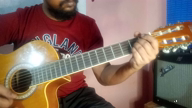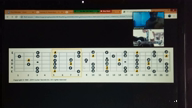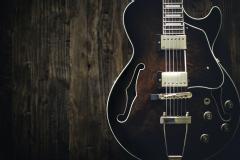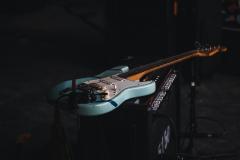Here’s a beginner-friendly guide to get you started with guitar. We’ll break it down into sections that cover basic skills, techniques, and knowledge you need to get comfortable with your instrument.
1. Getting Familiar with Your Guitar
-
Parts of the Guitar: Know the main parts:
- Body: The large part of the guitar
- Neck: The long part where the frets are located
- Headstock: The top part where the tuners are located
- Strings: Typically 6 strings, though some guitars have more
- Bridge: The part where the strings are anchored at the body
-
Types of Guitars: Acoustic, electric, or classical (nylon strings). As a beginner, an acoustic guitar might be easiest to start with.
2. Tuning Your Guitar
- Tune your guitar regularly to avoid frustration. You can use a tuner, tuning app, or online tuner.
- Standard tuning (EADGBE):
- 6th string (lowest) – E
- 5th string – A
- 4th string – D
- 3rd string – G
- 2nd string – B
- 1st string (highest) – E
- Standard tuning (EADGBE):
3. Basic Chords
Start with some basic open chords. Practice switching between them smoothly.
- E major
- A major
- D major
- C major
- G major
- E minor
- A minor
- D minor
4. Strumming Techniques
- Hold your pick with your thumb and index finger.
- Start by practicing basic downstrokes (strumming downward).
- Once comfortable, try upstrokes and combine them to make smoother strumming patterns (e.g., Down, Up, Down, Up).
Strumming patterns to practice:
- Down (D)
- Up (U)
- Down, Down, Up, Up, Down (D, D, U, U, D)
5. Simple Songs to Play
These songs are perfect for beginners because they use a few simple chords. Start slow and gradually build up speed.
- "Horse with No Name" – Two chords (Em and D6add9/F#)
- "Knockin' on Heaven's Door" – G, D, Am, C
- "Twinkle Twinkle Little Star" – C, G, F (easy way to practice chord transitions)
- "Wonderwall" – Em, G, D, A7, C
6. Finger Exercises
- Strengthen your fingers and get used to pressing down the strings cleanly:
- Chromatic exercise: Start with the 1st fret on the low E string, and go up one fret at a time until you reach the 4th fret. Repeat for all strings.
- Spider exercise: Move your fingers in a "spider" motion up and down the fretboard to get more finger independence.
7. Learning to Read Guitar Tablature
Guitar tablature (tab) is a simplified way to read music specific to the guitar. It uses numbers that represent frets on each string. For example:
e|---0---|---3---|---5---|
B|---1---|---3---|---5---|
G|---0---|---0---|---0---|
This means:
- e string is the high E string
- 0 means an open string (no fingers pressed)
- 1, 3, and 5 are the fret numbers you press
8. Practice Tips
- Consistency is key: Practice daily, even for 10–15 minutes.
- Be patient with yourself: Don’t worry if things are slow at first. Every guitarist was a beginner once!
- Use a metronome: It helps improve timing and rhythm.
- Record yourself: It helps you hear mistakes and track progress.
9. Beginner Guitar Songs List
Start learning songs that match your current skill level and work up from there. Here’s a list of popular beginner songs that you can practice:
- "Bad Moon Rising" – CCR (C, G, F)
- "Let It Be" – The Beatles (C, G, Am, F)
- "Three Little Birds" – Bob Marley (A, D, E)
- "Hey There Delilah" – Plain White T’s (C, D, G, Em)
- "Chasing Cars" – Snow Patrol (A, D, E, F#m)
10. Moving Forward
- Once you feel comfortable with basic chords, start learning bar chords (these use your index finger to press down multiple strings).
- Work on fingerpicking techniques to add variety to your sound.
- Learn more about scales (like the pentatonic scale) to help with soloing and improvising.
Bonus: Helpful Resources
- YouTube Channels
- Apps: Yousician, Fender Play, Ultimate Guitar (for tabs)
Take it one step at a time, and enjoy the journey! If you have any questions or need help with specific things, feel free to ask.














